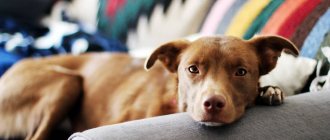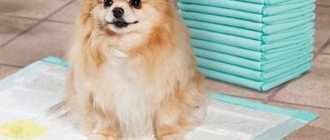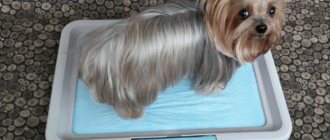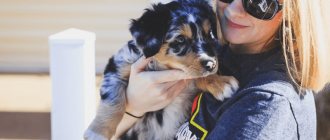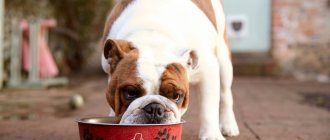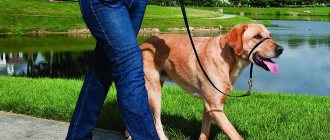The main principles of canine hygiene
Hygienic rules, along with diet, walks in the fresh air, and activity, have a direct impact on maintaining the health of the dog.
The complex of hygienic principles includes care for hair and skin, eyes and ears, paws and teeth. Their condition needs to be assessed regularly.
Warning: Excessive bathing, such as bathing too often, can be harmful to your dog's body.
Pets living outdoors, in a kennel or enclosure, do not need to be washed with cosmetics. More often, swimming in natural bodies of water and washing with a hose in extreme heat is enough for them.
A good hygiene option is to dry brush the wool with snow during the winter months. By rolling on clean surfaces, the dog removes dirt from fur, skin, fleas, and other parasites. But it is necessary to minimize contact with snow mixed with reagents used to treat pedestrian sidewalks and highways. After walking on them, the dog's paws should be thoroughly washed.
Wash your paws after a walk
After a walk, a dog's paws usually need to be treated to remove dirt, especially if they live in an apartment.
If the weather is dry outside and the dog is running on asphalt or grass, then sometimes it is enough to wipe the paws with a damp cloth; it is convenient to brush off the sand with a special soft brush.
If the dog has soiled its paws with dirt, and perhaps not only them, then it is best to wash the contaminated parts with warm water. But if your pet got into some kind of unpleasant substance (and dogs are very skillful at finding this kind of thing), then be sure to use dog shampoo or soap for daily use to wash it off (for example, Gulen , Four Paws , Shoe Zooarena brands and Pchelodar - shampoos, liquid soap, sprays for cleaning paws).
Photo: Phil Everatt
You can wash your paws after a walk either using a special basin right in the hallway, or in the bathroom, where you will either have to carry your pet (suitable for small dogs) or walk it along the corridor (large dogs will be difficult to carry and place in the bath).
To wash paws in a basin, you need to select a container of a suitable size depending on the size of the dog. It is better to use a basin with a wire rack and pour warm water from the ladle onto the paws so as not to dip them in dirty water. For small dogs, you can use a new, unused cat litter box. After washing each paw, wipe it dry with a soft cloth.
The most convenient way to wash paws in the bathroom is with a shower - a stream of water perfectly cleanses dirt. You should wipe your paws dry after completing the procedure.
If you use a hygiene product to wash your paws, first dilute it in a small amount of water. Then apply to paws and massage lightly, then rinse thoroughly. Do not put too much pressure on the pads, as there may be microtraumas on them after a walk. Sprays are simply applied to the paws and wiped with a cloth.
After washing and drying the paws, inspect the pads for any damage (peeling, cracks, irritation). If detected, it is recommended to apply a special cream or spray to care for paw pads (for example, Pchelodar , Care , Trixie ).
Private homes often have a separate shower section for dogs.
Paw washers of different sizes
There is also a special device for washing dog paws - a paw washer. This is a container shaped like a vase or a large mug; inside there are soft brushes, and on top there is a restrictive rubber band that prevents water from splashing. Before use, pour water into the paw washer, then simply insert the dog’s paw and make several up and down movements with the device.
Specifics of washing dogs of different breeds
The main purpose of bathing is to cleanse the coat and skin. Domestic decorative dogs that are not taken outside regularly and relieve themselves in a litter tray do not need frequent procedures. There is no need to frequently wash representatives of smooth-haired breeds, pets with coarse hair or short undercoat. This cover has the property of self-cleaning. The procedure should not be performed frequently if you are prone to permanent hair loss. For example, French bulldogs have this feature.
All short-haired dogs, Dalmatians, Boxers, Dobermans can be cleaned “express” using a technique that minimizes water consumption. Mix a tablespoon of vinegar and vodka in a glass. The sponge is moistened with the solution, wrung out, and used to wipe the wool. This method perfectly removes dirt and odors.
When caring for puppies in forced home quarantine, washing is not used, just washing is enough. There is no need to bathe older dogs with reduced elasticity of their skin and coat without any reason. Washing with shampoo will worsen their condition.
How to properly wash a dog
You should prepare for bathing your pet in advance. An hour and a half before the procedure, you need to close the windows and turn off the home air conditioner. Remove bathrobes and things that are being dried on the radiator from the bathroom - this property may get wet when the dog shakes himself off. Prepare cotton swabs for the ears, a towel, a terry cloth or sponge, a washcloth, shampoo, and conditioner for rinsing. If the dog is large, a collar may be needed. It will allow you to restrain your pet if it resists the “head wash”.
Place a rubberized mat on the bottom of the bathtub, basin, or shower stall floor to prevent your dog's paws from slipping on the surface. The sink can be covered with cloth. Place a cloth near the bathing area so that the dog does not injure himself by slipping after the procedure.
If you have a long-haired dog, dilute the shampoo and lather it, this will lather your dog evenly. Keep jars of detergents and rinse aids open so you don’t get distracted later. Fill the bathing container with warm water to approximately the animal's knees. Bring your pet into the bathroom and close the door.
- Insert cotton swabs into your dog's ears; they can be coated with Vaseline. There is no need to insert tampons deeply. It is enough that they do not fall out.
- Place the dog in the “pond”, water it with a shower - first the back and neck, then the tail and paws. All wool should be well saturated with water.
- Apply shampoo or foam solution to the dog’s “fur coat” and lather it evenly. If your dog has long hair, rub the detergent in the direction of the hair growth, otherwise it may become tangled.
- Rub the dog's entire body thoroughly, excluding the head. Wipe your face separately with a damp cloth or washcloth (without soap). If there are wrinkles, wipe each one. Wipe your ears only from the outside.
- Rinse off the foam thoroughly with water from the shower. Be especially careful in rinsing your armpits and neck, where shampoo usually accumulates. The detergent is rinsed off until the water running off the wool becomes clear.
- For long-haired dogs, it is advisable to apply conditioner to the damp “fur coat”. It is washed off after 3-5 minutes.
- Wring out the fur and cover the dog's back with a bath towel or microfiber so that the fabric absorbs water.
- Pick up the dog and place him on a dry cloth, keeping in mind that he will immediately begin to shake himself off.
- Take cotton swabs out of your pet's ears, give him a treat and praise him, even if he rebelled.
Representatives of breeds prone to colds should be wrapped up and taken to a warm place without delay. In summer the dog can dry itself, but in winter it is better to dry the coat with a hairdryer.
Regularity of washing dogs
Veterinarians recommend washing pets with shampoo and soap no more than once a month. After walks, you need to wash your paws with water or wipe them with a damp sponge or cloth.
It should be remembered that detergents have a negative effect on the epidermis. They eliminate the natural lipid layer, which leads to dryness and decreased protective properties.
Disgust makes some owners thoroughly wash their pets to eliminate the specific dog smell. These actions have the opposite effect. The destruction of natural protection causes the sebaceous glands to work more actively, which leads to a more pronounced odor. In addition, too frequent washing activates shedding and causes skin diseases.
Attention: Experts recommend frequently washing dogs with medicated shampoos if they are prone to skin diseases and allergic reactions.
The other extreme, refusal to wash, is no less dangerous. It should be taken into account that dirt on wool:
- stops its growth;
- leads to stalling;
- makes combing difficult;
- worsens aesthetic indicators.
Owners of elite dog breeds participating in show class exhibitions have no questions about the optimal washing schedule. Thorough cleaning is carried out before each “outing”.
How can you wash your dog?
Choosing the wrong detergent for your dog can cause deterioration of the coat, dermatitis, eczema and dermatosis. Therefore, it is equally important to know how to wash your dog. Human shampoo is not suitable for a dog, since the animal’s skin is different from the human epidermis. You should not use laundry soap and various folk remedies so as not to spoil your pet’s skin.
The pet is washed with special products for dogs. List of things you can use to wash your dog:
- cosmetic shampoos and liquid soaps that remove dirt and are suitable for frequent use;
- hypoallergenic shampoos for pets suffering from allergies to cosmetics;
- medicated shampoos against fleas, ticks, fungus and bacteria as prescribed by a doctor;
- tar soap to repel parasites.
Important! After using tar soap, you will have to deal with an unpleasant odor. It will disappear only after 2-3 hours.
Preparatory process
Before washing, a long-haired pet should be combed and old hairs removed. This will make bathing and drying easier. You also need to remove stray tangles and prevent tangling. You can use Ring 5 in preparation. The spray moisturizes the coat and prevents hair from being pulled out.
You can wash your dog in a shallow trough or bathtub, the bottom of which is covered with a cloth or rug. Anti-slip coatings will provide the dog with stability and eliminate stress.
When washing, the water should be comfortable for the pet, the optimal temperature is 35-40°C.
When should you wash your dog?
An unwashed dog is natural. Dogs are lucky and do not sweat in the “human” sense. Even in summer, they can easily ride the subway and raise their paws without hesitation. When they are hot, they simply stick out their tongue to cool down their internal ardor a little. Therefore, dogs need to wash themselves much less often than we do. If your dog smells bad, the problem is more with the skin or coat than with its cleanliness. There is no such thing as “it’s time for the dog to take a bath.”
The dogs are always quite clean. And there are only three reasons to wash your dog with shampoo:
- Hygienic. If the dog has been lying around in mud or something foul-smelling, it must be washed. Don’t wait for the next wash because “it’s too early.” Most often you have to wash hunting dogs that are trying to mask their natural scent.
- Therapeutic. Therapeutic bathing is one of the most common methods of external treatment for skin diseases in dogs. The frequency and means for such washing are prescribed by the doctor. Make an appointment with a dermatologist if your dog has skin problems.
- Cosmetic. This bathing is for “beauty”, so that the coat shines and is easy to comb. Usually dogs are washed before shows.
There is no need to wash your dog for no reason.
Jan 14 2021 at 10:58 PST
Washing the dog
There is no guarantee that your dog will enjoy the bathing process. It is worth carrying out the procedure in clothes with long sleeves, which prevent scratches from dog claws.
There are a few more recommendations from experts:
- eliminate drafts;
- use a collar, leash;
- Do not wash your dog's hair after ear cropping;
- Place old sheets and a blanket on the bathroom floor to soften the jump if the pet breaks free.
Attention: When bathing a dog, you should not be rude or aggressive; you need to encourage and praise your pet. After the procedure, you should reward the dog with a treat.
Rules for bathing dogs
- The dog is bathed after a walk, not before it. The time period for the water procedure is selected so that the pet has time to dry before the next walk, taking into account that the undercoat of representatives of a number of breeds can remain wet for several hours. Otherwise, your pet risks getting a serious cold, especially in the cold season.
- The dog must be calm. If your dog is overexcited, wait until he calms down, otherwise bath time will turn into a dramatic fight.
- The water for washing the dog should be warm. The optimal temperature for bathing large pets with dense coats is 34-37 °C, for small dogs – 35-38 °C, for “hairless” dogs – 37-39 °C.
- Long-haired or curly-haired pets are recommended to be brushed before bathing. The procedure is repeated after washing.
- Animals should be washed with special zoo shampoos. It is advisable to first wash the product in your hands with a small amount of water and then apply it to the wool.
- Shampoo and conditioner must be rinsed off very carefully, checking to see if any foam remains in nooks and crannies on the dog’s body.
- Dry the dog with a towel, gently touching the fur. There is no need to rub or ruffle your hair.
- If the apartment is cool, you can dry your pet with a hair dryer, choosing a mode with low speed and low speed. The air flow should not be directed towards the dog's face. If you frequently bathe your dog, constant use of a hair dryer is not recommended.
- Many dogs do not like to be bathed, so they should be taught to bathe from puppyhood. But it must be borne in mind that children are more prone to colds than adults. During and after the washing process, special care should be taken to ensure that the dog does not become too cold. The “wash” should be gentle and not accompanied by causing pain to the puppy. After each procedure, he must be rewarded with a treat. Over time, puppies get used to washing, and, having matured, they do it willingly or, in any case, do not panic or rebel.
Choosing a cosmetic product
An illiterate choice of shampoo can cause dermatitis, allergic reactions, and hair loss. It is impossible to recommend a specific shampoo for all dogs. You need to choose a shampoo taking into account the individual characteristics of the dog.
Important components for dog shampoo are egg yolk, lecithin, lanolin. Thanks to these components, it is possible to maintain the normal structure of the dermis and coat.
Attention: Anti-flea shampoos cannot be used for preventive purposes. These products contain toxic components.
Using shampoos
There is no need to pour pure shampoo on your dog. It is diluted with water in a small container. The sequence of the procedure is as follows:
- the wool is well wetted;
- paws and body are treated with a sponge dipped in soapy water;
- The armpits, groin area, and area near the anus are thoroughly washed;
- the head is raised up, washed, excluding water from getting into the nose, eyes, ears;
- All areas are thoroughly rinsed with a shower to completely remove the soap solution.
Attention: The cleanliness of the wool is checked by pulling it between your fingers. When dirt is removed efficiently, it creaks and there is no slipping.
When washing, you can use conditioners and balms that provide protection from UV rays and prevent wool from matting. These cosmetics are also mixed with water.
How to bathe a dog?
Of course, you can buy a special dog shampoo at a pet store or veterinary pharmacy, which will also rid your pet of fleas and ticks. There are a huge number of shampoos on the market for dogs for different types of coat. Just give me the money. But if you have children living in your house, you can use their shampoo. I think they won't mind. It is advisable to have less fragrance in the shampoo. After all, a dog’s sense of smell is many times better than that of humans and it will not be comfortable.


